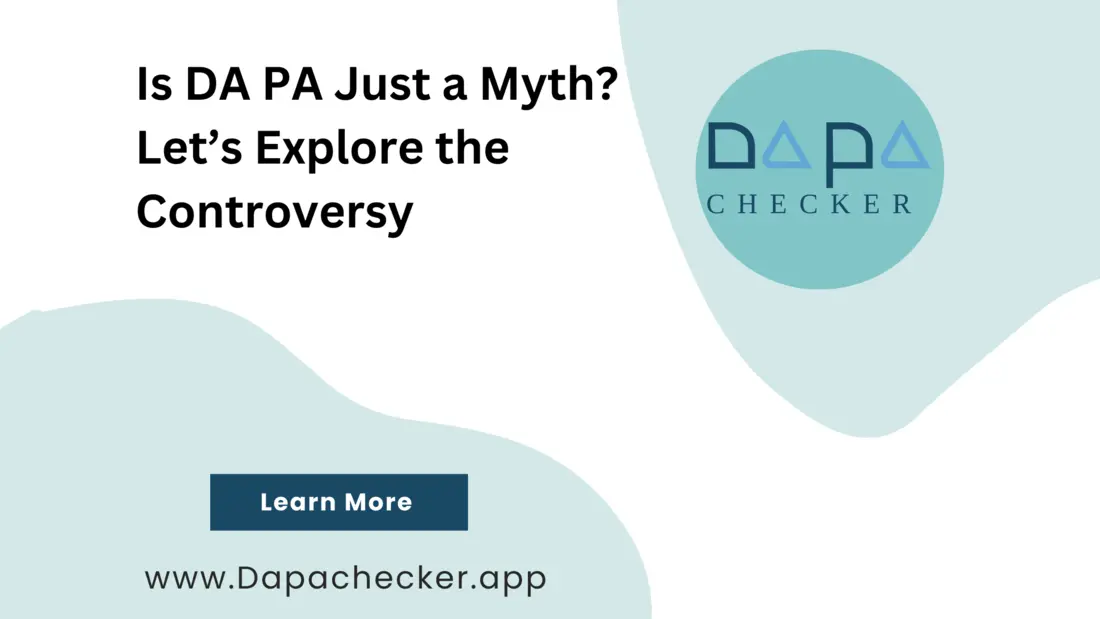Domain Authority (DA) and Page Authority (PA), developed by Moz, have long been considered as vital metrics in the world of Search Engine Optimization (SEO). These metrics provide a numerical representation of a website’s or webpage’s authority and credibility. However, there’s a growing debate in the SEO community about whether DA and PA are truly reliable or merely a myth.
Some critics in the field of SEO argue that these metrics are nothing more than a myth, emphasizing the number of backlinks as the sole determinant of DA and PA. On the other hand, some point to numerous high-DA PA websites enjoying substantial traffic and argue for their relevance. In this article, we’ll explore this debate and examine the arguments of both schools of thought.
Critics’ Arguments: DA PA is a Myth
Manipulable by Backlinks:
One of the primary arguments against the reliability of DA and PA is that they heavily rely on the number of backlinks and ignore their quality. They argue that Backlinks can be manipulated, bought, or generated through spammy practices, which can artificially inflate a website’s authority and hide its true value.
Increased through Link Schemes:
Link schemes, such as private blog networks (PBNs), exist solely to manipulate metrics like DA and PA. When websites engage in such schemes, their authority can increase significantly, even if they lack meaningful, high-quality content.
Inaccurate for Niche Sites:
DA and PA don’t accurately reflect the authority of niche-specific websites. These sites might have fewer backlinks but still provide valuable and authoritative content for a particular audience and getting good traffic.
Static Scoring:
One of the most reasonable arguments that is DA and PA scores are not updated in real time. As a result, they cannot reflect the current state of a website. A website’s authority could have changed, for better or worse, since the last score update.
Limited Metrics Considered:
DA and PA scores merely depend upon backlinks. They don’t take into account other vital SEO factors, like user experience, content quality, mobile-friendliness, and site speed.
Varied Backlink Value:
Not all backlinks are equal in value. A single high-quality, relevant backlink may be more valuable than several low-quality ones. DA and PA metrics don’t differentiate effectively between these distinctions and count them as equal.
Inconsistent Across Tools:
Different DA PA checker tools provide their own authority metrics, each with variations in calculation methods and scores. This inconsistency can lead to confusion for SEO professionals.
Overemphasis on Quantity:
DA and PA mainly emphasize the quantity of backlinks over their quality. So, this Way, these metrics can be increased by having a lot of spammy backlinks.
Influence of Redirects:
DA and PA can be influenced by redirects. When a domain is redirected to another, the authority of the new domain may be disproportionately inflated.
Limited Insights into User Intent:
DA and PA don’t consider user intent, and thus may not reflect a page’s relevance for specific search queries. A webpage may have high PA but not necessarily align with user search intent.
Supporters’ Argument: DA PA is Valuable
Supporters of DA and PA argue that these metrics offer practical insights into website authority and can be indicators of a website’s performance in search engine rankings. Let’s explore the arguments they gave to support their statement.
Correlation with Ranking Success
Most of SEO critics believe that websites with high DA and PA often rank well in search results, as they give the example of Nytimes.com having a 100 DA score and getting traffic in millions.
Critics also say that DA and PA metrics are helpful in assessing the real authority of any website if it is checked by a reliable DA PA checker tool, which doesn’t only consider the number of backlinks. It must assess the quality of backlinks as well as other factors such as content quality, user experience, and other ranking factors while assigning DA and PA scores to any website or page.
Conclusion:
While Domain Authority (DA) and Page Authority (PA) metrics serve as valuable indicators of a website’s authority. These metrics are susceptible because they can be manipulated by acquiring excessive spammy backlinks. In this way, they can provide an incomplete picture of a website’s true value. It’s important to consider these metrics in connection with a broader set of SEO factors such as user experience, content quality, and relevance to user intent when making SEO decisions. While DA and PA offer valuable insights, they should not be the sole determinants of a website’s SEO worthiness. Ultimately, the SEO landscape is complex, and conducting in-depth analysis is essential for success.
Frequently Asked Questions
Is it possible for a website to have a high DA and PA but not rank well in search results?
Yes, it is possible. While DA and PA are indicative of a website’s authority, search engine rankings depend on a variety of factors. High DA and PA should be complemented with other SEO efforts for better rankings.
Are there any alternative metrics to Domain Authority (DA) and Page Authority (PA) that can be used in SEO analysis?
Yes, several other metrics, such as Trust Flow, Citation Flow, and various Google-specific metrics, can be used in conjunction with DA and PA for a more comprehensive SEO analysis.
Can I manipulate DA and PA scores to improve my website’s authority artificially?
While it is possible to manipulate these scores temporarily through unethical practices, such as acquiring low-quality backlinks, it’s not a sustainable or recommended strategy. Search engines continually refine their algorithms to detect and penalize such practices, making them counterproductive in the long run. It’s best to focus on improving authority organically through high-quality, relevant content and ethical SEO techniques.


Leave a Reply